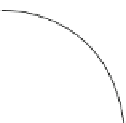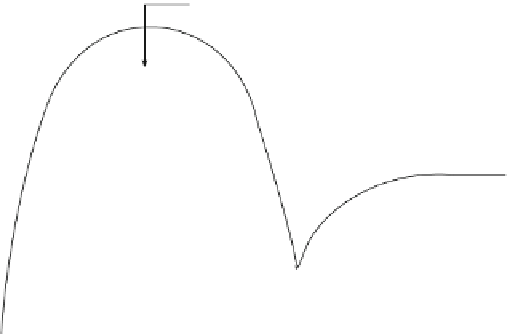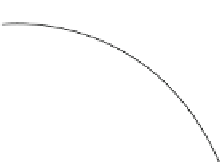Biomedical Engineering Reference
In-Depth Information
core profile shown by the dashed curve in
Figure 6.2-17
(i.e., refractive index is circular symmetric).
Furthermore, to solve the wave equation we resort to
a ray optics method of analysis based on the WKBJ
method (after Wentzel, Kramers, Brillouin, and Jefferies
[Morse and Feshbach 1953]). The WKJB approach is
a geometric optics approximation that works whenever
the refractive index of the fibers varies only slightly over
distances on the order of the optical wavelength. Imple-
mentation of the WKBJ approach to a graded-index fiber
yields that for a propagation mode to exist it is a necessary
condition that (
Cherin 1983
)
CORE
n
1
n(r)
CLADDING
CORE/CLADDIN
G
BOUNDARY
EXTENDED CORE
PROFILE
k
2
ðrÞ
b
2
y
2
r
2
>
0
(6.2.40)
r
Figure 6.2-18
a illustrates
k
2
(
r
) and y
2
/
r
2
as a function of
the radius
r.
The solid curve in
Figure 6.2-18
b shows
k
2
(
r
)
y
2
/
k
2
as a function of
r.
For a fixed value of
b there exist two values of
r
(
r
1
and
r
2
) such that
Figure 6.2-17 Physical profile of a graded-index fiber.
The solution of the wave equation leads to a ''character-
istic equation'' for the guide which relates b to k.T
O
simplify the analysis we first assume that the refractive
index continues to decrease in the cladding following the
k
2
ðrÞ¼
y
2
r
2
b
2
¼
0
(6.2.41)
(a)
k
2
(r)
2
k
2
(a)
r
2
r=a
r=a
r
r
(b)
2
k
2
2
--
β
≥
0
r
2
Bound Mode Region
2
k
2
(
r
)-
r
2
2
β
k
2
(a)
r=a
r
1
r
2
r
Tu r n i n g Points
Figure 6.2-18 Wave number diagram for graded-index fiber.
























































